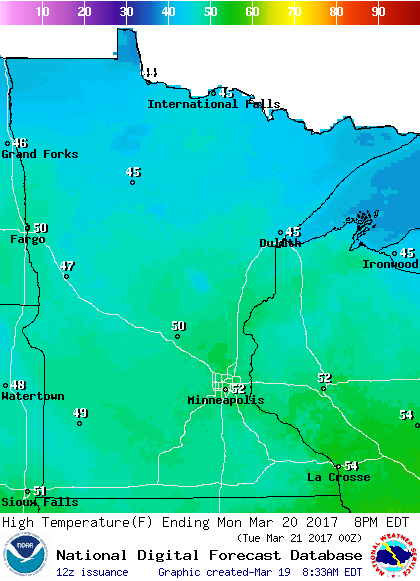Sunday warmth; astronomical Spring on Monday
Our highs this Sunday afternoon will be typical of mid April.
I hope that you get out and enjoy the warmth, and don't think about things like tax deadlines.
Much of Minnesota will see Sunday highs in the 50s, with some 60s over southwestern Minnesota and parts of west-central Minnesota. Northeastern Minnesota will top out in the upper 40s.
Our average high this time of year is 43 degrees in the Twin Cities.
Create a More Connected Minnesota
MPR News is your trusted resource for the news you need. With your support, MPR News brings accessible, courageous journalism and authentic conversation to everyone - free of paywalls and barriers. Your gift makes a difference.
Highs will be a few degrees cooler in most spots on Monday:

The Twin Cities metro area will see highs in the lower 50s Monday, and lower 40s Tuesday and Wednesday. High temps rebound into the upper 40s for Thursday and Friday.
Rain and snow chances
Eastern Minnesota and western Minnesota could see an isolated shower late Sunday afternoon or Sunday evening.
Monday through most Wednesday should be dry, with scattered rain/snow showers possible Wednesday night.
A low pressure system moving out of the Rockies will spread rain and snow over Minnesota on Thursday, and periods of precipitation will continue on Friday.
The National Oceanic and Atmospheric Administration’s Global Forecast system model shows the potential precipitation pattern:

The color chart to the right of the loop refers to the hourly precipitation rate, not inches of rain or snow!
Southern Minnesota and the Twin Cities metro area could see mostly rain on Thursday and Friday, but a more southerly track of the low pressure system would increase our chance of seeing flakes.
We’ll keep you updated as we get closer to Thursday.
Astronomical Spring
To many meteorologists, Spring runs from March through May.
We like each of our four seasons to be three months long, and define the seasons by temperature. Winter covers the three coldest months, December through February, and summer runs from June through August.
Astronomers use the position of the sun to define seasons, with Spring beginning on the day in March when the noon sun is directly overhead at the equator.
The Vernal (Spring) equinox occurs at 5:29 a.m. CDT this Monday.
According to EarthSky:
Earth doesn’t orbit upright, but is instead tilted on its axis by 23-and-a-half degrees, Earth’s Northern and Southern hemispheres trade places in receiving the sun’s light and warmth most directly, as Earth orbits the sun. We have an equinox twice a year – spring and fall – when the tilt of the Earth’s axis and Earth’s orbit around the sun combine in such a way that the axis is inclined neither away from nor toward the sun.
On the vernal equinox, per Sky and Telescope:
Day and night are almost exactly the same length; the word "equinox" comes from the Latin for "equal night." (A look in your almanac will reveal that day and night are not exactly 12 hours long at the equinox, for two reasons: First, sunrise and sunset are defined as when the Sun's top edge — not its center — crosses the horizon. Second, Earth's atmosphere distorts the Sun's apparent position slightly when: the Sun is very low. Have these facts on hand when you get the inevitable calls at the equinox from people saying your sunrise and sunset times must be wrong because they are not 12 hours apart.)
The Sun rises due east and sets due west (as seen from any location on Earth). The fall and spring equinoxes are the only times of the year when this happens.
If you want to know exactly where east or west are, Monday would be a good day to watch the sun rise or set, according to EarthSky:
This fact makes the day of an equinox a good day for finding due east and due west from your yard or other favorite site for watching the sky. Just go outside around sunset or sunrise and notice the location of the sun on the horizon with respect to familiar landmarks.
If you do this, you’ll be able to use those landmarks to find those cardinal directions in the weeks and months ahead, long after Earth has moved on in its orbit around the sun, carrying the sunrise and sunset points northward
After the vernal equinox, the sun will set north of west for several months in the northern hemisphere:

After the autumnal equinox in late September, the sun will set south of west for several months.
A few years ago, NASA posted a video that illustrates how the sun angle shifts as we go through the year.
Programming note
You can hear my live weather updates on Minnesota Public Radio at 7:49 a.m. Thursdays and Fridays, and at 7:35 a.m. and 4:35 p.m. each Saturday and Sunday.